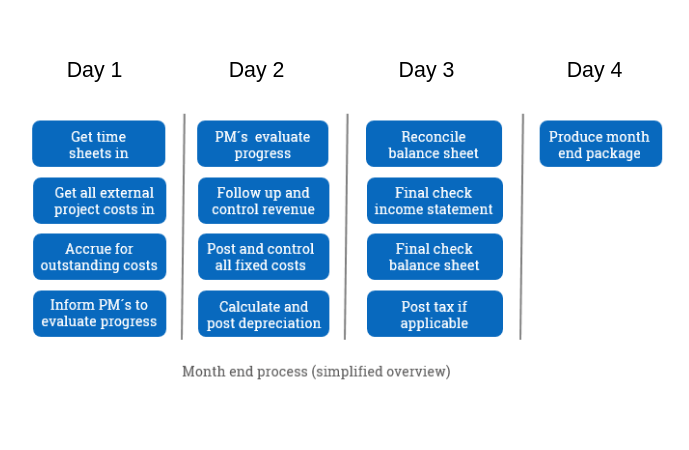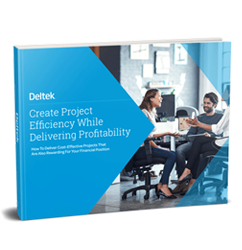The Month-End Process: How to Accelerate Each Step

Tweet it: 'The Month-End Process: How to Accelerate Each Step'
What Is Month-End Close, And Why Is It So Important?
Does your project-based firm scramble to balance the books month after month? Do you think there might be a better way to compile timesheets, assess project progress, and issue invoices to your clients, but you’re not sure how to streamline these disparate project management and finance processes?
As a regular, recurring event, your month-end close should be performed with the same level of accuracy and rigour as a year-end close. The month-end process involves matching incoming revenue to outgoing costs, to produce reconciled balance sheet. As such, it’s likely to engage most members of your finance department.
The month-end close process is crucial in project-based firms for two main reasons. Firstly, it involves the production of financial statements, which provide a true and accurate reflection of the firm’s current position, and these – in turn – provide solid foundations for future decision-making.
Secondly, end of month accounting ensures the firm remains compliant with internal and external financial and regulatory standards; and it provides regular oversight of internal finances in order to quickly pick up on any anomalies, including fraud.
Financial Management Best Practice
Create project efficiency while delivering profitability.
How Many Days Should Your End Of Month Accounting Take?
In some project-based firms, the month-end accounting procedure can unwittingly become a long and uncontrolled process, dragging out over six or even eight days, but if you implement a series of planned tasks throughout the month, it needn’t become an onerous ordeal. Ideally, one week or less should be sufficient to gather all of the required data and complete the necessary reporting.
"Ideally, one week or less should be sufficient to gather all of the required data and complete the necessary reporting."
In fact, by taking advantage of technology, you can potentially streamline your month-end close procedure to just three or four working days, leaving more time throughout the month to manage other business functions, and plan effectively for the future.
To assess whether your current month-end close process is robust and efficient, ask yourself the following four questions:
1. How many days do you spend on month-end accounting procedures?
Your month-end process should be smooth and fast, and should take no more than three to four working days. Start by compiling accounts receivable data – in most firms this is known as revenue recognition – to determine the past month’s accounts receivable income using timesheets, at the commencement of each new month.
2. How efficient is your month-end close process?
In some firms, the process of undertaking revenue recognition may still be a partially manual process, while other firms have achieved significant time savings by automating this task via fully integrated software solutions that collate electronic timesheets from employees across the firm.
3. Have you delegated responsibility for revenue recognition to project managers?
Timesheets should be completed in a timely manner, and project managers should be tasked with overseeing this function.
There are two main advantages to be gained from delegating this responsibility outside the finance team: firstly, it streamlines month-end close, and secondly it places responsibility for Time and Money outputs in the hands of project managers, who are best placed to make adjustments to project workflows.
4. How effective is your month-end close schedule?
Your month-end close schedule should generate accurate and secure reports that enable the finance team to properly reconcile and substantiate the balance sheet.
The speed of your month-end close execution will obviously differ from your competitors depending on the size of your firm, and which technologies you have available to expedite this process.
Read on to find out how technology solutions can deliver month-end close process improvements.
How Do You Speed Up The Month-End Close Process?
With the kind of business tools and technologies available today, you can reduce the time taken to execute month-end close to less than one week, and slicing days off your month-end close can add up to significant cost savings over the course of the year.
Under this ideal scenario, the finance team begins collecting revenue recognition and cost elements from project management teams on business days 1 and 2 of the new month. On day 3, the focus shifts to reconciliations and other impending areas, and on day 4, the month-end close process is completed.
What Does Month-End Close Best Practice Look Like?
The month-end close process flowchart below outlines the 13 steps that add up to month-end close best practice:

How To Master Your Month-End Processes
Step 1: Revenue recognition, Days 1 and 2
1. The Financial Controller (FC) and Project Managers (PM) collect all employee timesheets and posts results. Ideally, timesheets have been collected on a weekly basis throughout the previous month so that at month end it’s only necessary to collect and approve timesheets for the last week of the month.
2. The FC then accrues external project costs, including those related to sub-contractors and consultants, and any other external project costs. If you haven’t already implemented a purchase order system for external vendors and suppliers, doing so now will help to increase oversight over external project costs.
3. The FC provides work in progress (WIP) data to the PMs for evaluation on Day 2. PMs then evaluate progress on fixed price projects and the value of WIP on Time and Money inputs. PMs should be responsible for any write offs that are necessary at this stage.
4. The FC provides approved month-end close figures to the CFO, who approves any write-offs;
5. The FC approves and posts all adjustments.
6. The FC validates full month revenue.
Step 2: Finalize the income statement and reconcile your balance sheet, Days 3 and 4
1. After the process of revenue recognition, or in parallel to it, a number of additional month-end tasks need to be finalized across the Income Statement and Balance Sheet.
2. To complete the Income Statement, the FC should:
- register and post all remaining costs and accrue any missing costs
- update fixed asset spreadsheet, including calculating and posting depreciation
- validate income statement against expected budget
- calculate and post tax, if applicable.
3. To complete the balance sheet, the FC should:
- reconcile and check accounts receivable and WIP
- reconcile and check accounts payable
- reconcile and check bank accounts
- check and validate balance sheet as complete.
4. Once all these processes are complete, the FC finalises the full Income Statement and Balance Sheet for the month, and produces the reporting package for management.
What Are The Benefits Of A Faster Month-End Close?
Speeding up your month-end close can bring many benefits for your firm.
For one, you’ll find you can manage your payment schedules more efficiently and effectively, which ultimately increases cash flow and reduces administrative burden related to accounts payable.
And there are benefits arising from optimising accounts receivable and accounts payable processes, such as fewer invoice errors which can lead to faster payment and improved levels of client and supplier satisfaction.
You’ll also find it possible to identify early warning signals, such as whether a client may pay late, or whether a supplier hasn’t been paid so you can plan accordingly and adjust as needed.
And, if you do take advantage of software such as ERP, you’ll find you can even identify, monitor and reduce your firm’s Days Sales Outstanding (DSO) figure, a key indicator that records the amount of time it takes your clients to pay invoices owing to your firm.
"You’ll find it possible to identify early warning signals, such as whether a client may pay late, or whether a supplier hasn’t been paid."
What Is Best Possible DSO?
With software to manage your financials, you have a variety of reports available to help you monitor your DSO, aged accounts receivables, aged accounts payable and much more to provide an accurate reflection of where your firm stands financially.
Tracking and improving upon these significant metrics helps firms to achieve better cash flow management outcomes, which can lead to an increase in profit margins because unnecessary costs and administration are avoided while delays are more effectively managed.
How Can I Improve Month-End Reporting In My Project-Based Firm?
There are four main steps you can take to achieve time and money efficiencies in your month-end close process:
1. Define your recurring processes, and define and delegate those various tasks to the relevant employees to complete
2. Employ a software solution (such as ERP) to automate revenue recognition, thereby streamlining the flow of information between the project management and finance departments
3. Engage your project managers and other employees to evaluate work in progress across projects, to recognize the monthly revenue figures
4. Define the reports that make up your month-end close management package, and use technology to automatically generate those reports each month
By harnessing the power of technology to automate regular tasks and occurrences, and produce the reports that senior managers need, it’s possible to reduce your month-end close process to just three to four days, allowing the finance team to focus on monitoring firm key performance indicators, ensuring project managers are receiving the most up-to-date and accurate project information and providing the business intelligence the company needs to make better business decisions.
Financial Management Best Practice
Discover how you can create project efficiency while delivering profitability.

Deltek Project Nation Newsletter
Subscribe to receive the latest news and best practices across a range of relevant topics and industries.

 Log In
Log In














